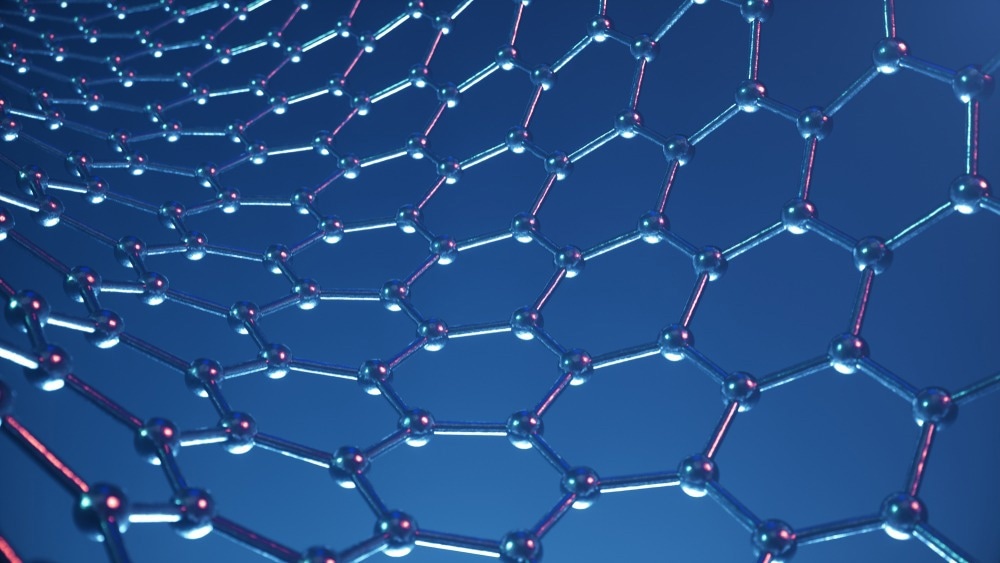A paper published in the Accounts of Chemical Research reported basic findings on the dry compressibility of holey graphene along with mechanistic analyses using atomistic models that rationalized this peculiar characteristic of holey graphene.

Study: Scalable Dry-Pressed Electrodes Based on Holey Graphene. Image Credit: Rost9/Shutterstock.com
Holey graphene belongs to a class of structural derivatives of graphene, having arrays of through-thickness holes with nanoscale diameters that are sporadically dispersed throughout the graphene nanosheet surfaces.
Why is Graphene So Popular?
Graphene is a revolutionary material that has the potential to develop new industries as well as replace current materials and technologies.
Despite having a thickness of a single atomic layer, graphene is chemically stable, much stronger than steel, has a large specific area, and shows excellent thermal and electrical conductivity.
Advancements in graphene research are having a significant impact on the domains of transportation, healthcare, electronics, and energy storage.
Preparation of Graphene
Graphene sheets having regulated thickness and large widths can be produced using chemical vapor deposition (CVD) and mechanical exfoliation techniques.
For uses that necessitate large quantities of materials like battery electrodes and composite fillers, graphene is usually produced by subjecting natural graphite to oxidative exfoliation. This process generates graphene oxide (GO), which is then converted into graphene via thermal or chemical reduction.
Surface defects are common in graphene derived from GO, which is not a disadvantage as these surface defects can create possibilities for future chemical transformations.
Graphene sheet functionalization generally implies the addition of an organic moiety and inorganic materials or heteroatomic doping.
What is Holey Graphene?
Holey graphene is a structural variant of graphene. For making holey graphene, sets of carbon atoms are stripped from the surface of a graphene sheet rather than adding more moieties or particles. This creates an arrangement of holes while maintaining the two-dimensional structure of holey graphene.
At first glance, it may seem that the holes make the sheet of holey graphene more "defective." This is not necessarily true, as the holes are created by inherent defect areas in the original graphene material.
If the hole formation mechanism is mild enough, the residual carbon structure retains its graphitic characteristics, as shown by negligible differences in experimental observations of the mechanical and electrical properties of holey graphene.
Advantages of the Holes on Holey Graphene
The existence of nanoscale holes in the large lateral region of two-dimensional holey graphene sheets results in unique functionalities.
An improved through-thickness mass transfer and, consequently, greater accessibility of the graphene surface area in the nanosheet stacks is a good example.
This property is particularly useful in energy storage systems, where holey graphene is utilized as the electrode material while the holes serve as easy passageways for different ions and electrolytic molecules.
There should be a clear understanding of the difference between the holes on holey graphene sheets and the traditionally described pores in carbon nanostructures and high-porosity graphene assemblies.
The holes are inherently present in the two-dimensional holey graphene nanosheet structure, whereas the pores are gaps and voids among neighboring graphitic surfaces.
A Natural Successor to Graphene in Energy Storage Applications
Graphene is a highly appealing conductive component in electrodes for numerous energy storage applications.
As holey graphene is a structural variant of graphene with superior characteristics, it has naturally evolved into a more sophisticated substitute for graphene in these applications.
The Verdict on Holey Graphene
Being a structural derivative of graphene, holey graphene exhibits a holey pattern which results in a negligible rise in defects but much-enhanced characteristics, particularly with respect to through-sheet mass transfer.
This property is quite relevant in energy storage applications, wherein decreased ion tortuosity results in significantly improved performance.
The porous character of holey graphene makes it possible for the dry powder to be compressed into composite structures or compact monoliths having electrochemically active fillers which may be employed directly as battery electrodes or supercapacitors.
Using a binder- and solvent-free dry-press technique with holey graphene allows for the facile production of electrodes with large mass loadings and a high areal capacity needed for use in practical battery systems.
In contrast, the traditional slurry-based electrode production method is time-taking and may cause environmental problems, as well as considerable difficulties in improving the active material mass loading.
In most situations, holey graphene functions as a structural scaffolding with binder-like qualities in dry-pressed electrodes and as a conducting additive.
With scalable fabrication processes available, holey graphene could be a highly attractive carbon material choice for potential battery electrodes with high energy densities, providing benefits in manufacturing as well as performance.
More from AZoNano: Nanotechnology and Dye Sensitized Solar Cells
Reference
Lin, Y., Plaza-Rivera, C. O., Hu, L., & Connell, J. W. (2022). Scalable Dry-Pressed Electrodes Based on Holey Graphene. Accounts of Chemical Research. Available at: https://doi.org/10.1021/acs.accounts.2c00457
Disclaimer: The views expressed here are those of the author expressed in their private capacity and do not necessarily represent the views of AZoM.com Limited T/A AZoNetwork the owner and operator of this website. This disclaimer forms part of the Terms and conditions of use of this website.